Ryan DeJonghe - The Avid Reader
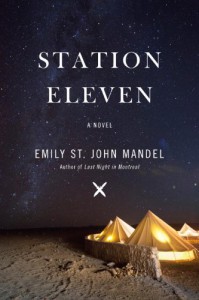
Last night was a beautiful night. The moon was full and reflecting gorgeously over the water. A ship was waiting off the coast with its lights on, probably waiting to pull into New York today. As I took in the scene, I was reminded Emily St. John Mandel’s novel STATION ELEVEN. In it, a character was sitting on a similar beach, yet in a country across the world and at a different time. Yet that beauty was shared. And throughout this novel, even at the worst and most tragic of times, beauty remains.
There are leaves holding several places in my copy of this book. I read most of this in the woods sitting by a campfire last week. The leaves mark places of the book I enjoyed—there are many. The leaves remind me of the rustic future Emily paints. There are no more airplanes, no more refrigerators, no more of our daily conveniences: the things that we so easily take for granted and let slip through our daily lives unnoticed. Poignant would be a great word to describe the effectiveness of this novel’s writing.
The characters are shown in various time periods: the fondness of yesteryear, the reality of today, and the glimpse of future, both cursed and hopeful. Connections are shared throughout, showing how one act precipitates another. There is a sense of tightness though the chapters are often broken in their order.
As with other great authors, but unique in her own voice, Emily St. John Mandel brings out the enriched, realness of each character and emotion. What stood out brilliantly in my mind are the simple things of life—the things from which produce happiness and satisfaction. Poetic would be another excellent word to describe STATION ELEVEN. It is not spare like McCarthy, but neither does it flounce in excessive verbiage.
In the end, my message is this: this book is about beauty, everyday beauty. Cherish it, embrace it, be it. Thanks to Emily St. John Mandel, we can see it.
Thanks to A.A. Knopf for sending this to me for review.
 1
1
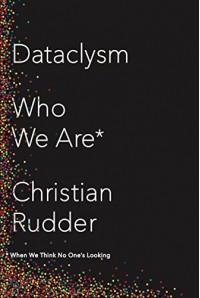
If you are a Twitter user, congratulate yourself: your average word length is greater than Shakespeare’s. If you are a man or a woman, I know what age group you find most attractive. I also know those naughty and bizarre things you search for in Google.
Okay, I fess up. I don’t know YOU, but I know the collective representation of you thanks to Christian Rudder’s new book DATACLYSM. And, dang it…I know a bit more about myself, too.
Rudder got me interested in his book when he started talking about the dating site he co-founded, OKCupid. So much data! I loved peeking in with him as he explored what happened when photos were removed from the site and people went on blind dates (hint: ugly folks make great dates). Then later when the pictures were made larger (hint: beautiful people received tons more messages; homely folks even fewer than before). Everything was extrapolated, even down to the average keystrokes versus average message length of messages (can you figure out how 1,000 letters are typed just by pressing 10 keys?).
Rudder kept his Harvard math powers rolling through Twitter, Craigslist, Google, and—my favorite—reddit. WARNING: I spent way too many hours last night rolling through Google trends. Be prepared. You will lose precious time fondling the data in this book.
One more thing: Rudder is hilarious and insightful. Describing what we learn from Google, he writes, “It’s the site acting not as Big Brother but as older Brother, giving you mental cigarettes”. Going back to Twitter versus Shakespeare (average word length 4.8 versus 3.99, respectively), Rudder writes, “Looking through the data, instead of a wasteland of cut stumps, we find a forest of bonsai.” As for the data on his OkCupid site, he writes, “People saying one thing and doing another is pretty much par for the course in social science.”
The one thing I can complain about is the length of the book: I want more! At 300 pages, I would say about 100 of those pages are devoted to end-of-book references and section-introduction pages. The good news is that Rudder has his blog with tons more data, and the book has its own site, too. The book’s site is supposed to have several tools on it, such as an algorithm to predict if you are going to divorce or break-up based on your Facebook profile. Those features were not available before the book’s publication.
Bottom line: tons of data and insight provided through creative charting and exquisite writing. I love it.
Thanks to Crown for sending this to me for review. Pure awesome!

Shelly King has stolen my heart: books, love, and fantastic writing.
A few months ago a great book called THE STORIED LIFE OF A.J. FIKRY came out. It had everything I enjoy in a book; it was essentially a love letter to people who love books. The only faults may be that the story was straight-forward and a bit short. Predictable, if you will. Author Shelly King takes these premises and fills in any shortcoming in her newest book THE MOMENT OF EVERYTHING. Indeed, she has offered everything.
As a tech lover and fellow nerd, I found much to relate to within King’s writing. Her experiences working within Silicon Valley shine through, from everything from Farmville references, to beating tunes on Guitar Hero, to programming the latest iPHone app. King won me over with her written description of becoming “the mayor” of a local independent book store. Two wins: books and tech.
I couldn’t put this down. I know, I know, you’ve heard that cliché before. But seriously, King’s writing displays such a warmth and comfortable feeling that you’ll instantly connect. Go ahead, check out the first page of the preview: I bet you can’t resist turning to the second page. King taunts you, by telling you that books aren’t the magic elixir everyone says they are. And yet…
The plot. I had no idea where King was taking me. Sure, I read the description and even peeked at the end-of-book group discussion guide, but the story was wonderful (and as mentioned before…addictive). There are several levels of characters, both the ones we meet in the margins of a classic and heavily used book, and the ones frequenting the book store. Each one is relatable and recognizable to our everyday life.
Bottom line, this is a great story written incredibly well. This will be a big hit for anyone loving a good book, especially those appreciating books in used condition, and for anyone looking for an unexpected love story. Bravo, Shelly King.
Thanks to Grand Central Publishing for sending this to me for review.

I’m not a fan of labels, but the best description of this review is of a “Christian” reviewing a “Buddhist” book. This is a timely book that coincided with my reading of TANTRIC COCONUTS. That book was a work of fiction with a life-teaching lesson that illuminated my eyes to this: a person can deepen their Christian practice by also following the teachings of the Buddha. To some, this is sacrilege. To the open and willing, there is amazement and transformation.
While many Buddhist Christian books focus on the Gospel of Thomas, and the producers of this book have much of that on their website, this book stays away from that focus. This book is primarily a teaching of the Buddha with many ancillary Biblical scriptures used for effect. Note: if you are reading this to deeper your Christian walk, make sure you are already familiar with the Biblical scripture used; know what you already believe.
As for this book itself, it took me a long time to work through it. This is a working commentary that often causes moments to pause, ponder, and reflect, inspiring long moments of meditation. I appreciated the introduction to many of the written words and sayings, much of it being overlooked by previous Westernized books of the Buddha. I’m especially thankful for the ongoing commentary to help my understanding of the older language and original translations.
There were quite a few surprises for me here: mainly about the sayings of disciplines, punishment, and punitive repercussions due to one’s own actions. I found that much of what is discussed in the early sections of this book would prevent much of that threating and rewards of the latter. Specifically, meditation with a disciplined focus will steer correctly.
Thanks to the folks at Light of the Spirit for sending this to me for review.

HAPPINESS BY DESIGN seeks to take Paul Dolan’s training in economics and behavioral science and offer a unique approach to overall happiness not found in other of its same-shelf counterparts. This is an interesting approach, considering Dolan is working with Daniel Kahneman, who won the Nobel Prize in economics as a psychologist. (It must be nice to refer to a Nobel Prize winner as “Danny”.)
Dolan claims to make two distinguishing factors on the path to happiness: relatability and definition. Dolan speaks to his lower class upbringing and his current group of friends that are both college educated and those who are not. After reading this book, I’m not sure if he creates a completely relatable experience or not, but more on that later. As for the definition, Dolan states other books on happiness have never offered a definition of happiness. His definition is, “experiences of pleasure and purpose over time.” He later calls this a life “that contains lots of positive sentiments of pleasure and of purpose”, labeling it as “sentimental hedonism”.
My two favorite quotes in this book are: “Your happiness is determined by how you allocate your attention.” and, “If you are not as happy as you could be then you must be misallocating your attention.” Dolan’s method of bringing about happiness is a balance of pleasure and purpose, for as he writes, “If you are not as happy as you could be then you must be misallocating your attention.” The problem is that we “generally pay attention to what we think should make us happy rather than focusing on what actually does.”
I appreciate Dolan’s scientific-like approach, which is my main contention with books such as THE HAPPINESS PROJECT that feature more “feel good” statements and “it worked for me” statements. A lot of what Dolan offers resembles Rick Hanson’s book HARDWIRING HAPPINESS, which is one of the best I’ve read of the subject. Both this book and that book feature focused attention on everyday events.
There are hundreds of footnoted studies that Dolan uses to effect. By the time he wraps up, he presents ways to “decide, design, and do” that will organize your life around long standing happiness. In particular, Dolan shows how current happiness surveys capture a moment of response, such as posing for a camera, versus a more accurate capturing of happiness over time, such as video recording someone that isn’t posed and gives a more life-like representation.
The parts I would like more clearer or more defined research are the effects of: mindfulness, sleep, and happiness for the unemployed. Dolan believes, though not explicitly pointing to, books like THE POWER OF NOW by Eckhart Tolle offer obtainable happiness by at a cost of the mind’s System 2 effort (taken from Daniel Kahneman’s THINKING, FAST AND SLOW). Dolan writes that it is “easier and more effective to nudge system 1 than it is to shove system 2.” Dolan’s messages are interesting and remind me a lot of Daniel J. Levitin’s recent THE ORGANIZED MIND.
As for sleep, Dolan shows an interesting study comparing spiked happiness of those who stay up late versus the continuous overall happiness of those that forgo late-night television in order to get a full night’s sleep. As for unemployment, Dolan continuously shows studies how working and money both directly and indirectly affect happiness. On one hand Dolan speaks of the advantage of finding work via happiness, but on the other speaks of the depressiveness of unemployment. This shows me a slippery slope that needs more resolution (which I believe mindfulness or Hanson’s HARDWIRING HAPPINESS addresses).
Overall, HAPPINESS BY DESIGN is an excellent scientific approach to understanding how to obtain continuous overall happiness through simple organizational techniques. This book provides plenty of new insight through hundreds of studies and relatable material. While I would like more information on some of the presented material, there are plenty of footnotes and end-book references for me to follow-up on.
Thanks to Hudson Street Press and The Penguin Group for providing an electronic copy of this book for me to review.
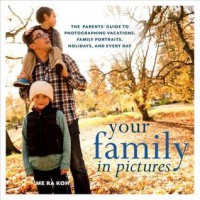
Two things will happen when you read YOUR FAMILY IN PICTURES by Me Ra Koh: you’ll want to buy a better camera (especially if you are a currently relegated to using your cell phone camera), and you’ll want to buy Me Ra Koh’s other two books.
For the better camera: yes, the author gives great tips on how to take better pictures with your phone or point-and-shoot camera. However…you’ll begin to see all these GREAT pictures featured in the book, many taken with perfect lighting and high-end cameras. The author makes mention in her “recipes” for better photos to change the ISO settings and shutter speed, etc. Many lower-end and phone cameras have these features in a limited basis, but you’ll definitely notice the difference between your pictures and the pictures featured in the book.
As for the other books: the author often mentions them. She’ll talk about camera basics, such as the law of thirds or negative space, but it is enough to make you want to read them. Other reviewers of this book (FAMILY IN PICTURES) have also mentioned how great of a companion all three books have been. It’s not a bad thing, just be forewarned.
Regarding the advice itself, you will see improvement in your overall photos. Me Ra Koh gives some great introduction instructions (e.g., finding the right lighting in your home, what cloths to wear, etc.), and then breaks into situational sections (e.g., holidays, outings, etc.). There are numerous tips here that will give you great ideas on how to take a satisfying photo—with or without that $1,000 camera (though you’ll still want that $1,000 camera).
The quality of this book is top-notch. Don’t let the “paperback” throw you off. The cover is glossy and thick, and each page is full color and glossy as well. It is comfortable to read and easy to look-up particular advice. An electronic version on the Kindle Fire or iPad would be okay, but I would stay away from a Kindle Paperwhite version due to the high amount of color used in this book.
Bottom line: great book for beginners, as well as people with some already established picture knowledge seeking improvement. Not just for families, but for any picture taking featuring people.
I received this book for free for review through Blogging for Books.

This is not a happy book, but rather is a necessary one. The title is emotional, the back-book selection is tear-producing, and the entire book is utterly heart-wrenching. Through descriptive writing, author Steve McGarva highlights the horrid atrocities animals (not just dogs) suffer on the beautiful island of Puerto Rico.
I couldn’t finish this: my heart was broken too many times. The things the author describes are beyond abuse: they are straight-up evil. Horses being pulled apart by trucks, dogs skinned…. I would flip to another chapter, and more pain was revealed. Even as I read about the author’s concluded journey on the island, I could feel the agony about his descriptions of recent history of government-sponsored groups throwing dogs from high bridges. I could not bear it.
Though many courageous workers are offering their services on the island, the author can be noted for raising the standard through key media outlets, such as PEOPLE Magazine and the Ellen Show. Through his empathetic hurt and burden, and now through his book, the message is spreading. Hope and light are being made available for these precious dogs.
Another reviewer has noted several organizations fighting for this cause: Amigos de Los Animales, Manos Por Patas, The Sato Project, All Sato Rescue (author’s affiliation), Island Dog, Save a Sato, ARF Rincon, Culebra Animal Welfare, Second Chance Animal Rescue.
I want to thank Dey Street (formally It Books) for sending this book to me for review, as well as publishing it for people’s awareness.
 1
1

This book nails it: both the feeling of conflict and the conclusion of duty back home. I’m impressed at the realistic inclusion of both officer and enlisted, especially both sexes, male and female. The repeated exposure to war, though not completely understandable or always justified, has both physical and psychological consequences to everyone involved. Though each service member has bonding similarities, everyone is affected uniquely. Author Michael Pitre expresses this perfectly. For that, I want to thank my military brother.
I am a former Marine and currently work helping my fellow Veterans. FIVES AND TWENTY-FIVES captures what many civilians want to know, but so few returning military members wish to express. Thankfully Pitre, was trained in writing before he signed up for training in combat. He took that writing expertise to war—twice—returning with the capturing of unequivocal knowledge. As a writer and a Marine, Pitre relays experiences unparalleled to many of this written genre.
I’d like to pause and highlight a fantastic review from someone who served in the Marines with Pitre: https://www.goodreads.com/review/show/986162637?book_show_action=true&page=1
In particular, this book focuses on several different people involved in the conflict of Iraq: officer, enlisted, Navy Corpsman, and Iraqi interpreter. Initially, it felt like separate stories, which I would have appreciated as well, but then the stories began weaving more and more together. Pitre’s method brought about the intricate relationship every member has with one another, whether in peace-time uniform, in shoulder-to-shoulder combat, or discharged back home.
If you were never in the military and want to know more about our men and women coming home and still serving overseas, this is the book to read. If you were in the military and want to understand more about modern-day effects of multiple combat tours: read this book.
I want to thank Bloomsbury for providing this book electronically for me to review. And for the author, Semper Fi, brother.

10% HAPPIER came at the right time for me. It is both laugh-out-loud funny and deeply compelling. Author Dan Harris writes intelligently, yet without any snobbery. His self-effacing, realistic style is relatable and interesting. I started reading this months ago when I first started studying mindfulness; I just finished this after reading several similarly-themed books in between. Harris’s book stands on its own as a great resource, as well as an excellent memoir.
The first few chapters provide shockingly real views behind the news desk. Harris does not mince words when described himself and fellow newsroom superstars, such as Peter Jennings. Harris dives deeper into his rise and his catastrophic fall. The video we see captured on YouTube of Harris stumbling is nothing compared to what he reveals about himself during these chapters.
Here is the video of Harris’s on-air panic attack: https://www.youtube.com/watch?v=_qo4uPxhUzU
Coming from a similarly-discussed religious organization, I was surprised to see Harris’s early involvement with such church groups—and what lies behind the scenes. As his chronologic journey progressed, he talks about meeting with Eckhart Tolle and Deepak Chopra. I am a fan of both these gentlemen, especially Tolle, but I could readily laugh at Harris’s candid opinion of both. His opinions are real, but not totally disrespectful (no one goes under his comment-radar).
About halfway through the book, Harris starts to explore Buddhist philosophy and traditional mindful meditation techniques. He finds a way to engage in his life while being in the moment and feeling connected. Through his efforts he has become a successful advocate for mindfulness and meditation.
The book concludes with some great recommended reading selections and FAQs on meditation. This may be new for people just seeking the behind-the-news look (and it is captivating) or it may be some nice continued lessons for those already immersed. Either way, this book is a win.
Here is a recent video of Harris talking about “hacking” the brain via meditation: https://www.youtube.com/watch?v=FAcTIrA2Qhk
Here’s a nice video on ABC: http://abcnews.go.com/WNN/video/dan-harris-meditation-path-happiness-22871879
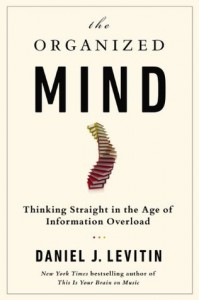
Daniel Levitin’s ORGANIZED MIND seeks to take the figurative junk drawer of our mind, explain how the mind works, and help us live more thought-out and productive lives. His knowledge comes from his own years of teaching and research and has been influenced by mind pioneers such as Daniel Kahneman, Amos Tversky, and Mihaly Csikszentmihalyi. The end product is an awesome journey into the realms of our minds that enlighten and inspires action.
This book is huge. At times Levitin may appear longwinded in his narrative—but that’s okay. Trust me. As he unravels the various layers of mental organization, he sidebars into various studies and interesting factoids. At first, you may think Levitin is being ironically unorganized, but later chapters tie it back together. Other times, Levitin may tuck in a brief statement that will cause you tunneling into Google for more information (though many notes for further study are linked at the rear of the book).
Levitin differs himself from Kahneman’s THINKING, FAST AND SLOW by saying there are “four components in the human attentional system”: mind wondering mode; central executive mode; attentional filter; and, attentional switch. What mostly comes into play are the first two components. I have some issue for the terminology “mind wondering mode”; I would have liked Levitin to expound more on mindfulness and what component it falls into.
THE ORGANIZED MIND offers more explanation than step-by-step or bulleted technique. I appreciated this approach, feeling it strengthened the technique through knowledge of why it works. Levitin uses the ideas of offloading brain information through index cards, calendaring, contact sheets—much like our mind uses random access memory versus chronological memory. Some of these techniques were explained in the books THE POWER OF FORGETTING and ESSENTIALISM, but not nearly in the depth of knowledge that Levitin offers.
Category management is a huge topic throughout the book: reasonably so. It is one such tool that the recent FLUENT FOREVER book used in learning foreign languages. Levitin continues this insight into everything from organizing our homes to making life-depending healthcare choices. Levitin combines it all together, showing how Highly Successful Persons (HSPs) are able to succeed by naturally using these strategies.
I was pleased to see Levitin address the fundamental need for sleep, exercise, and exposing oneself to nature. These are not just “you should” statements, but as mentioned before, these are well-documented, scientifically-backed recommendations.
There are also sections dealing with procrastination, crowdsourcing, the dangers of multi-tasking and teaching children safe web research, and much more. It all plays into more information than you’ll want, but definitely will include any information you are trying to find or need.
All-in-all, this is a great book that’ll make you think and learn better. Thanks to Dutton for sending this to me for review.
 1
1
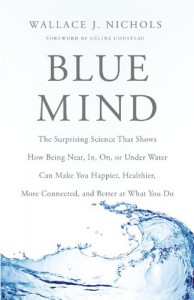
There’s only one way to read a book that touts the benefits of water: IN the water. It took me a little longer to get through this book because I literally read the entire thing while either floating or sitting in water. Why? Let’s see…
<img src= http://i.imgur.com/9bLUc8r.jpg>
“As children we delight in water. As we grow older, water also becomes the matrix for sport, relaxation, and romance.” As the author Wallace J. Nichols points out, water enlarges the price tag of property as well as increases the anxiety level of when our waterways are threatened (oil spills, etc.) But really, we all know we love water, right? Nichols takes it deeper than that.
The author does well to express our love of the water through examples of art, literature, and pop culture. He further shows how our bodies react to water stimuli through the science of EEGs, MRIs, and fMRIs. We the readers are witness to examples of how hospitals improve recovery times, Veterans with PTSD are soothed, and how our bodies recuperate. “Even indirect exposure to water has recuperative power,” as the author writes.
<img src= http://i.imgur.com/FuFcvJG.jpg>
Nichols continues by discussing recently favorited topics of mine: neuroplasticity, happiness, and wellness. I’m reminded of Thich Nhat Hanh’s teaching about mindfully washing the dishes, “There are two ways to wash the dishes. The first is to wash the dishes in order to have clean dishes and the second is to wash the dishes in order to wash the dishes.” Each of these daily experiences will better your life: to notice the water running over your washing hands; to drink mindfully a cup of water; to stop and stare, appreciating any vista of water you happen across.
In the long run, why is it worthy to learn the benefits of water? Not only are we bettered personally, but we are sparked to action. We care. As the author writes, “Let it heal you and make you a better, stronger version of yourself.”
Thanks to Goodreads and Little, Brown for sending me this book through their giveaway contest.
One more quote featured in Nichols’s book: “Thousands have lived without love, not one without water.” – W.H. Auden
<img src= http://i.imgur.com/QXNAAoP.jpg>

This book feels a bit short and outdated. A 20-year-old (target audience) following Charles Murray’s advice would stand out, but not necessarily in a good way. They’d appear disconnected and unimaginative. They may be polite, well-dressed, and properly spoken, but those are the people that often fly under the radar. For a better book about getting ahead, read WHO GETS PROMOTED, WHO DOESN’T, AND WHY by Donald Asher. It is also published by Crown (under the 10 Speed imprint), but feels much more modern, and has greater, well-researched details about “getting ahead”.
Murray’s advice is not all humdrum. He does include some excellent resources for further reading, as well as insight into timeless clichés that still have valued meaning. It never hurts anyone to be polite, without sucking up, and to dress well. Some of this may be taught more by mentoring or coaching, versus this book.
Murray’s grammar section takes up a third of his book; it barely scratches the surface, and even what it does contain sounds stiff. Look at Steven Pinker’s recent article in THE GUARDIAN that discusses why it is okay to break certain grammar rules (all of the “rules” he addresses are found in this CURMUDGEON’S GUIDE): http://www.theguardian.com/books/2014/aug/15/steven-pinker-10-grammar-rules-break (I will be reviewing Pinker’s upcoming book THE SENSE OF STYLE when it comes out next month.)
Because much of Murray’s presentation focuses on grammar, I’d be remiss not to mention June Casagrande’s GRAMMAR SNOBS ARE GREAT BIG MEANIES, which is a fun way to learn grammar and syntax rules. Casagrande also has a book out called THE BEST PUNCTUATION BOOK, PERIOD (also published under a Crown imprint) that is better than that curmudgeonly and mean spirited book EATS, SHOOTS & LEAVES (whose author wishes lightning strikes and burial upon users of poor punctuation).
I don’t believe Murray to truly be a curmudgeon. I believe he has a good heart and wants to help younger employees succeed. His effort at sounding “mean” in this book comes across as flawed. And again, the book is tiny (don’t give this as a gift thinking graduates will read this; get them something they’ll actually read): the book is about as tall as a dollar bill, a few inches wide, and under an inch in thickness. Besides talking about no piercings in the workplace, getting married, and finding religion, there’s not much content for your money.
Thanks to Crown and Blogging for Books for sending this book for me to review.
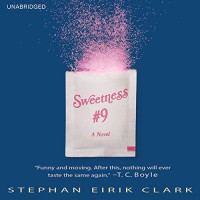
Here’s what I love about SWEETNESS #9: introducing me to Stephan Eirik Clark. His storytelling has a special flavor (sorry about that pun) that is fascinating and stands on its own. As the story progressed over decades of time, I felt the characters change. I wasn’t just a witness, but I could sympathize and feel. As a reader, I was involved with the characters making realistic connections along the way, especially true with protagonist David Leveraux.
The scariest story is that which mirrors reality. Clark often had me researching sweeteners and flavorings, including scanning through congressional reports. The best type of writing spawns action. And yes, while some readers may find certain final elements “preachy”, the narrative serves as a springboard for conversation. I think this is great.
The writing was so realistic that the final footnote convinced me to Tweet to the author asking for more information. And I do want to know more.
This is an interesting fictional work that goes well with non-fictional works like FAST FOOD NATION. The story element of SWEETNESS #9 offers several interesting facets: from personal and business details to the more global historic aspects. There’s liberty taken to enhance (again, sorry for the pun) the actual, real-life details, but it makes the pages flip all the faster.
For a more blow-by-blow account that I felt nailed the particulars without spoiling the surprises, here’s a review I found helpful on Goodreads by C.Purtill: https://www.goodreads.com/review/show/1005529589?book_show_action=true&page=1
I enjoyed all the author’s included elements, both miniscule and widespread. It all served to make an excellent reading package. Yes, some of the diet structures may skirt the boundaries of comfort, but that’s part of why I read: to question and to learn. Overall, this is a great book and is something that has whetted my appetite (sorry, last pun…maybe) for more.
Thanks Little, Brown for providing this electronically for my review.

There are several reasons to love this adaptation of Victor Hugo’s classic LES MISÉRABLES. For one, as a Westerner reading manga, the brain flips “on”. It’s like taking notes or drawing with your non-dominant hand: it pushes you to observe more. Then, the stylistic cartooning of manga pushes emotion to a higher level (the eyes get me, especially during the tearful, swelling moments). Finally, the inspiration to read the source material. Unlike reading condensed or review materials, reading this inspires continuation.
As for the story, the team involved did an excellent job capturing the essences of the book, the major plot points, and the character-defining moments—no easy task considering the volume of the source material! Yes, of course much is missing, but the spirit is all there: the life lessons and realities.
I’m a little spoiled with some other graphic novels that were in all color, so that’s my only wish to make this better. The cover and one opening page are in color, the rest penned in black & white.
Who this is for: fans of the original material, maybe. Mainly: folks that may have seen the musical or movie or just curious what the buzz is about. Not for students trying to pass a test; read Hugo’s original.
Thanks to Diamond Book and Udon for originally providing this electronically, and then for sending me the paperback version for review. Much better in print: again, the brain flip thing of magna (plus the awesomeness of art).
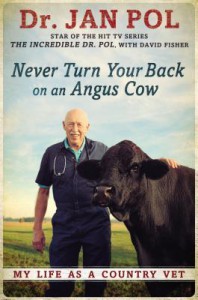
I may have never seen his show, but after reading this book I feel like I know and love Dr. Pol. My co-worker saw me reading this and asked, “Is that the guy that sticks his arm up a cow’s butt?” Before finishing the first chapter, I could reply, “Yes. Yes it is.” Or, as the awesome Dr. Pol writes, “for many people their careers as a vet begin the day they stick their hands inside an animal’s butt for the first time.” This all began in the Netherlands, gloveless, and green armed.
I’d imagine that Dr. Pol is mesmerizing to watch. To his credit, David Fisher did an excellent job of organizing all Pol’s stories into interesting categories to capture this same feeling. He groups stories together such as early beginnings of his education, to his own practice, etc. From there, you’ll go all over the place—and that’s totally cool. One minute Pol will be talking about scaring his wife with a snake for a $20 bet to castrating two-hundred pound pigs. And it’s all great reading.
Speaking of Pol’s wife, Dianne, of the early courtship, “How could anybody not find a woman who played tag with her pet duck attractive?” He’s so cute, isn’t he?
As he writes, Pol says, “until they start inventing new animals, I think I can say there isn’t a type of animal I haven’t looked in the eyes and wondered how it was feeling.” From there, and throughout the book, Pol talks about all kinds of animals: including skunks, porcupines, and even an alligator. Oh, and the wildest animal of all: humans.
Pol’s integrity shines through: “Be honest with your clients. That was always first. Work hard, and if you don’t know what the problem is, don’t be afraid to admit it.” Pol has a life experience unparallel to many, which makes him so darn interesting. From hiding cows from the Nazis (yeah, those Nazis) to filming the Amish: he brings it out so well.
“I became a vet because it was the only thing I ever wanted to do.” Thankfully his dad sold that cow for his son’s first microscope: as his clients and as many watchers of his show know, and now the many readers of his book, the world is a better place because of Dr. Pol.
Thanks Gotham Books for sending me this book to review. It was a pleasure.
 1
1

What happens when you get P.T. Barnum, President Lincoln, Walt Whitman, Ulysses S. Grant, The Queen, and John Wilkes Booth all in the same book? Oh, and a dwarf—two of them. Well, it should be really interesting, right? Publishers Weekly called it, “Top-notch entertainment”; Booklist called it “Rollicking”. I’m not sure which book they were reading, because this book could have been SO. MUCH. MORE.
Reading this, I’m kicking myself for not have visiting the Barnum museum in Bridgeport yet. I spent most of this book on Google digging out the true story of General Tom Thumb and P.T. Barnum and the Civil War. Yeah, that’s a great thing about historical fiction: It’s a great learning experience. It’s all a testament to the book itself. It wasn’t “fast-paced and brightly colored” as Kirkus said; it was more ho-hum and grayish-dull. Again, could have been SO. MUCH. MORE.
For a good summary of this book, check out TChris’s (Top 100 Reviewer) summary in his review: http://www.amazon.com/review/RE7L8YH6XLY65/ref=cm_cr_pr_perm?ie=UTF8&ASIN=1476727325
The author Nicholas Rinaldi has three collections of poetry that sound interesting, so I was looking forward to what the New York Times Book Review called “sprawling and elegant”. I really don’t make a habit of calling out and questioning other reviews, but when they are all over the product page…I kind of need to. Nothing aggravates me more than thinking the consumer is being duped (false author book blurbs are a big pet peeve of mine). If I was to call a book “sprawling and elegant”, even poetic, I would refer to ALL THE LIGHT WE CANNOT SEE, also published by Scribner this year. That work was an excellent piece of historical fiction that really made me feel something. Sadly, Tom Thumb did not entertain me the way he should have—the way he entertained thousands of people in real life.
Thank you Scribner for providing this book electronically for me to review.
 1
1


